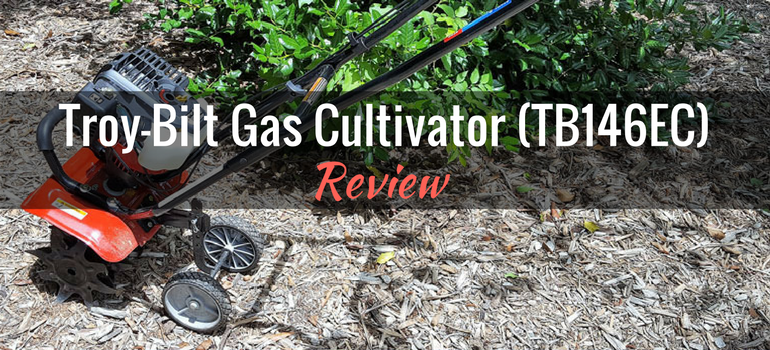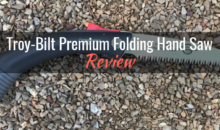Troy-Bilt Gas Cultivator (TB146EC): Product Review
We independently evaluate all recommended products and services. If you click on links we provide, we may receive compensation.
Aggressive yet refined, blending brute strength with good looks.
Available on Amazon
Buy ItI recently had an opportunity to test Troy-Bilt’s gas-powered cultivator (model # TB146EC).
Did you know that there’s a huge difference between a tiller and a cultivator? A tiller is the bigger, more powerful cousin of the cultivator, possessing enough weight and tine-depth to break up even the hardest, rockiest new ground.
You will NOT confuse the Troy-Bilt gas cultivator with a tiller. The Troy-Bilt’s light weight causes the unit to bounce up and down across virgin soil instead of penetrating it. But, like any decent cultivator, the Troy-Bilt excels in blending soil, mixing in fertilizer and compost, and controlling weeds.
The question is how good is good?
SPECIFICATIONS
| Weight: | 37 lbs. as shipped; 39 lbs. as oiled and fueled |
| Engine: | 29cc, 4-cycle |
| Starting system: | Standard recoil pull-cord; JumpStart™ engine starter sold separately |
| Fuel type: | Gas |
| Tines: | 6, eight-bladed, 6” forward-rotating steel tines |
| Max tilling width: | Adjustable 6” to 12” inch |
| Max tilling depth: | 5″ |
| Transport: | Rear wheels and front bumper integrated grab bar |
| Warranty: | 2-year limited warranty |
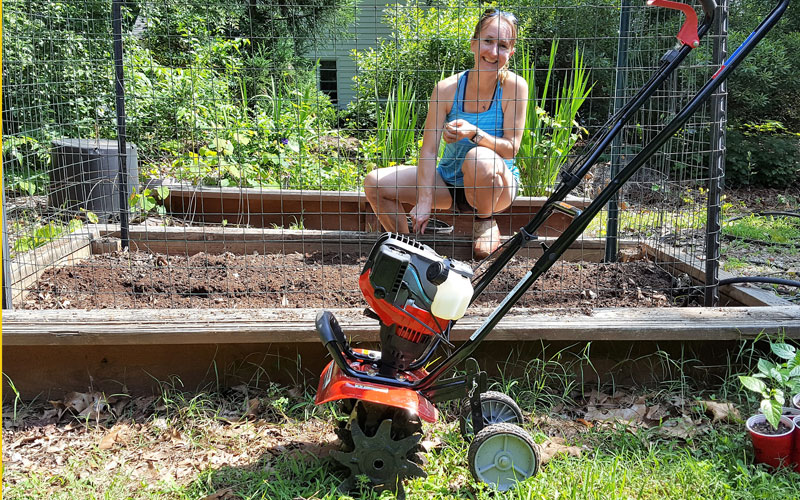
The Troy-Bilt Gas Cultivator in its natural habitat
Protective Packaging
The large (35” X 19” X 22” 14” x 13”) cardboard box showed up at my front door looking like it had been kicked a few times. Fortunately, the “box-inside-a-box” packaging kept the tool nicely insulated from any potential shipping abuse.
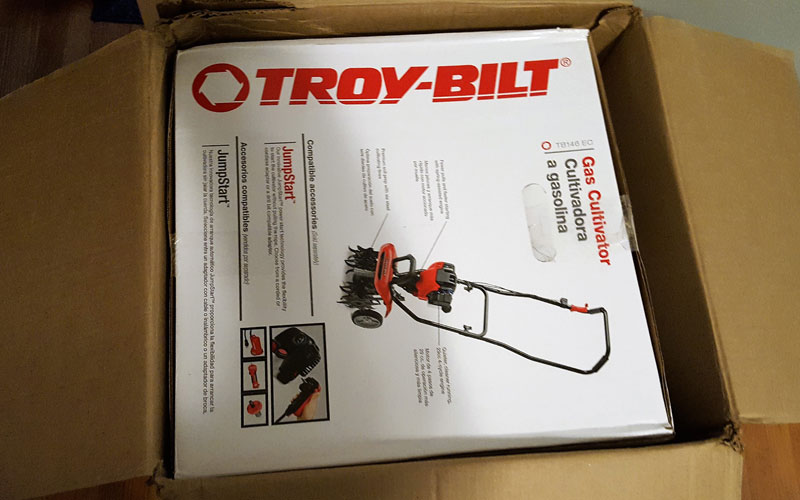
Secure “box-inside-a-box” packaging protects the tool in shipping
Once I opened the box-inside-the-box, the unit appeared to be in good shape. The bar used to attach the wheels to the frame had penetrated a piece of the internal cardboard during shipping, but this movement caused no damage except to leave a puncture mark in the cardboard.
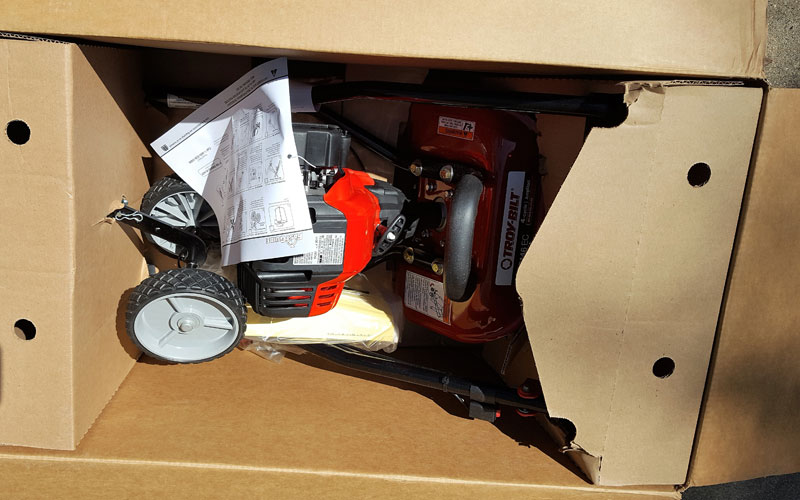
Interior air pockets and cardboard sleeves further nestled the tool.
EASY ASSEMBLY
After unpacking the box contents and laying them out on my driveway, I felt pretty certain that I could assemble this without an advanced engineering degree. I was right. In fact, assembly required no tools other than my hands and reading glasses (so I could see the detailed instructions).
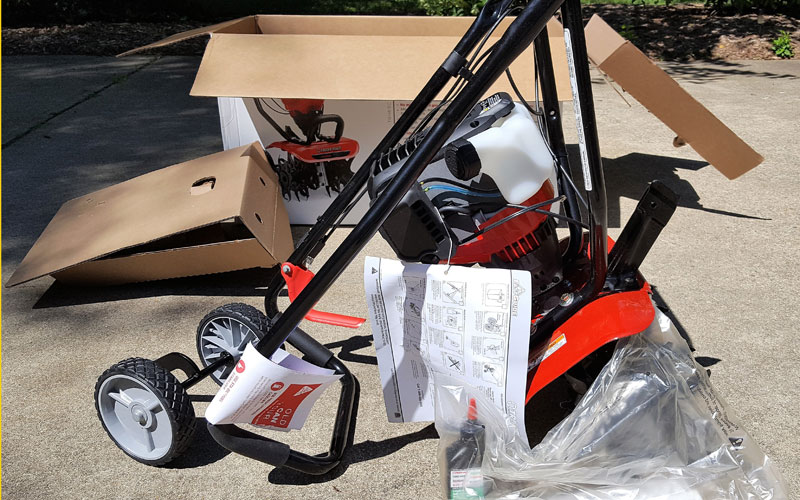
The Troy-Bilt comes 95% ready to roll
I read directions/instructions as a last resort, which might explain why I’ve actually assembled a foosball table with the players mounted backwards. When I scanned the “fast guide” operator’s manual, I saw 12 easy-to-understand diagrams of what I needed to do. In less than 10 minutes, I was ready to fire up the unit.
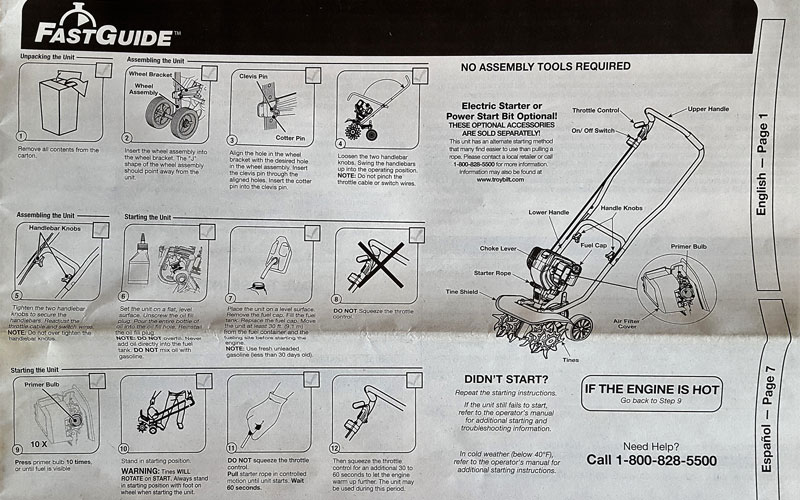
I love at-a-glance Operator’s Manuals that contain simple pictures
In case you think I’m glossing over complicated details, here’s what I did during those 10 minutes:
- Attached wheels by aligning holes and inserting the supplied cotter pin into the cleaves pin;
- Loosened, positioned, and tightened the two supplied handlebar knobs;
- Added supplied oil into the place marked OIL; and
- Added fresh gasoline (not included) into the tank.
READ THE STARTING INSTRUCTIONS
Companies often include reams of warnings and instructions just to cover themselves in the event that someone gets hurt using their product (e.g., lawn mower instructions saying “Don’t stick your fingers in the blade while it’s spinning”). But Troy-Bilt spells out detailed steps on starting (and running) the cultivator for a good reason: if you don’t follow the steps, it won’t run. And if you’re wondering how I know this, it’s because I didn’t read them until I couldn’t get the unit working.
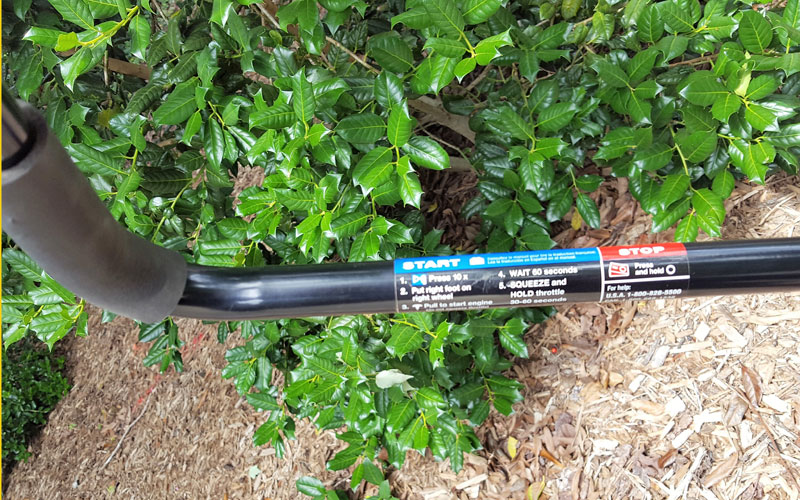
STARTING and STOPPING instructions are conveniently attached to the left handle
The good news is that Troy-Bilt stuck on them on the left handle. So read them. But here are a couple of details worth repeating. First, once the engine engages, let it run for a minute before you touch the throttle on the right side of the handle. Second, before you start using the unit, pull in the throttle to let the engine warm up for another minute. Trust me. Just wait. You’ll choke it out if you haven’t warmed it up both without and with the tines engaged.
The last thing you need to know is how to engage the throttle, meaning how to get the blades to rotate. Simply pull the hard-to-miss red level on the right handlebar towards you. It’s big enough to reach with a gloved hand. To disengage the throttle, let it go and the blades stop. To shut the unit off completely, flick the switch on the left handle to the OFF position.
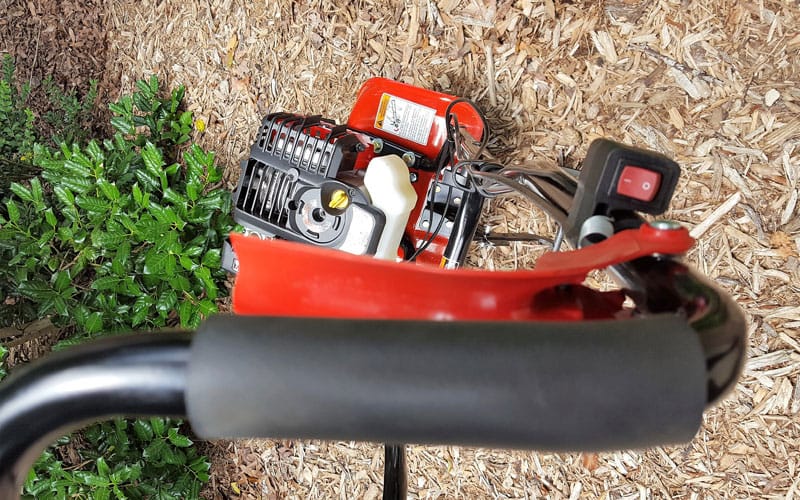
The over-sized throttle and ON/OFF switch are bright red and sit on the right side of the handlebars
HOW DID THE TROY-BILT PERFORM?
I tested the Troy-Bilt Gas Cultivator in the environment in which the engineers intended for it to be used: as a garden cultivator. But since I’m hard on my tools, I also tested the Troy-Bilt Gas Cultivator in the unfair conditions of my real-world environment.
Test #1: Turning soil
The 6 aggressive, eight-bladed tines provided plenty of bites when penetrating and turning the soil in both my pre-weeded and un-weeded garden beds. The weight and balance of the unit made it easy to maneuver around the beds.
In the unweeded beds, small weeds were chewed up and buried, and a few half-fist sized rocks got spit out in the process. However, long grass and weeds clogged the times after a few minutes of use. More on this later.
Test #2: Mixing in compost
Once I turned the soil, I added bags of peat, mushroom compost, cow manure, and sand to the beds. In less time than it takes my Vitamix to make a smoothie, the Troy-Bilt mixed the contents of my bed into a uniformly-colored blend of richness.
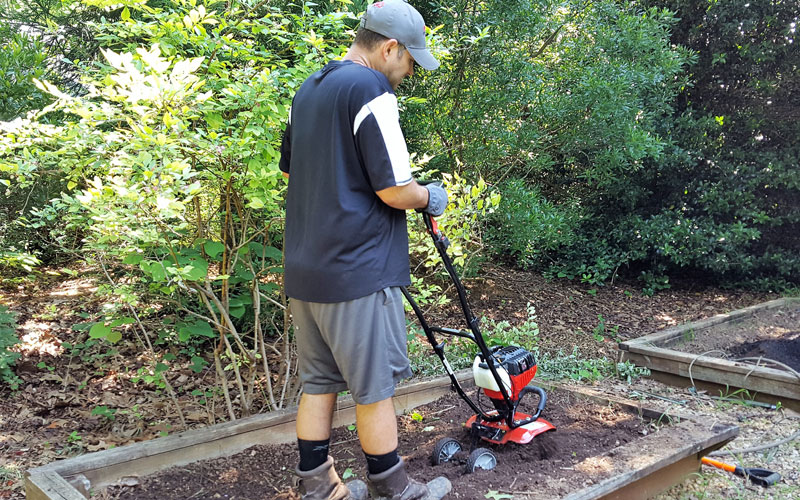
It had plenty of power to turn soil and mix in compost
While the operator’s manual claims this unit can go as deep as 5”, I found that if I didn’t keep moving the cultivator, those sharp, quickly-rotating blades started to dig a trench!
Test #3 Weeding
The cultivator had no problem dealing with the short weeds in my garden beds. I used it to ready the beds. Later, I went back to weed in between rows. My only problem was user error: I planted some rows too close together and couldn’t get between them. My bad. Where I planted them correctly, the cultivator made the weeds disappear.
But I took weeding to a new level. I have a patch of invasive, tall grass on my property. Last winter, I torched as much of it as I could, and this spring I mulched the area. Of course, the grass came back with a vengeance. I wondered how the cultivator would do in this environment.
I’m happy to say that it worked great…for a few minutes. In no time, the tines ripped into the mulch and removed the weeds. But it came with a price. The grass got firmly embedded in the tines to the point where the cultivator stopped rotating. I shut off the unit, tilted it back, and tried to remove the weeds with my gloved hands. Some pieces of long grass came out, but the tines were still entwined.
Had Troy-Bilt attached the tiller blades on the outside of the unit with either spring or cotter pins like many other tillers, clearing debris would have been as easy as popping the pin out, sliding off the blades, and removing the debris. However, Troy-Bilt placed their cotter pin inside the tiller blades, in a place buried by the very weeds that stopped the unit.
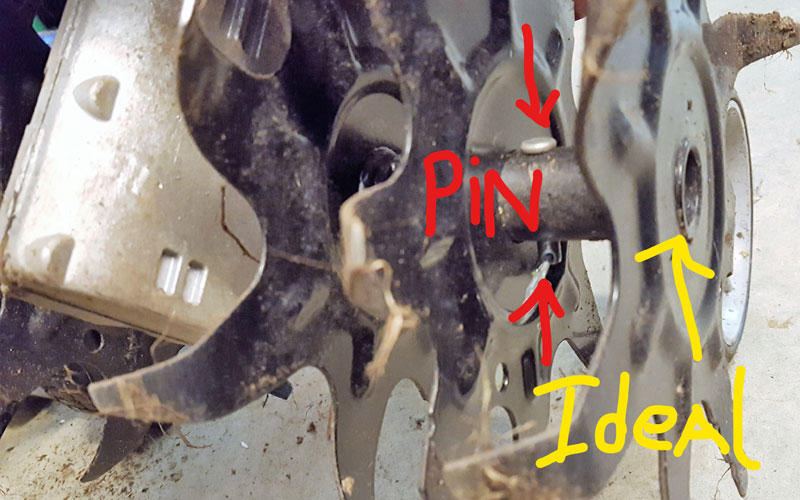
The internal vs. external placement of the pin made cleaning out the tines and blades frustrating
After using a knife, pliers, and too much time, I removed the weeds from the blades. While the cultivator did a great job on that grass, the long cleaning time made me suspend my efforts.
Test #4: Tilling virgin earth
North Carolina means different things to different people. To me it means impermeable red clay. I know that a cultivator is NOT meant to till hard earth like a tiller would, but I gave it a go to see how it would work.
Not surprisingly, it failed. What makes the Troy-Bilt gas cultivator great to use in a garden (its light weight and maneuverability) worked against it on hard ground. I held the unit firmly as I engaged the tines across the edge of my yard. It bounced up and down like a kid on a trampoline. After a couple of minutes of “tilling” the same spot, I examined the results. A metal-tined rake would have marred the ground as much as the cultivator did.
What I was asking the little cultivator to do is akin to expecting a sports car to haul bricks through the woods. On virgin, rock-hard soil, this little cultivator—like any other cultivator I’ve tested—is NOT the right tool for the job. So this last test result (a most unfair one) in no way shaped my overall impression of the cultivator.
Warranty
Troy-Bilt products come with a limited 2-year warranty covering defects and workmanship. If you have a problem, they will repair or replace any part free of charge (their option).
Recommendation
I love the Troy-Bilt Cultivator, and I’m not alone. Two of my neighbors have the same unit and provided unsolicited praise about their experiences.
Here’s what I love about the Troy-Bilt Cultivator:
- When it comes to turning and mixing soil (doing the work a cultivator is designed to do), it offers superior performance.
- The powerful, lightweight unit is very easy to maneuver.
- It’s 4-cycle engine means there’s no need to pre-mix gas and oil.
- The fit and finish are BMW-esque, which is a nice, unexpected extra in a tool made to mix soil with cow poop. There is nothing clunky about the unit. Every part feels refined.
- The front bumper/handle makes lifting and transporting a snap.

Note the conveniently-located combination front bumper/carrying handle
- If it’s important for you to know (e.g., how to start, stop, engage tines, add oil, etc.), it’s marked clearly on the unit so you don’t have to dig out a manual each time you use it.
- If you have trouble with pull-starters, you can use the JumpStart™ engine starter (sold separately).
- The handle can be folded down for transport or storage.
Here’s what I didn’t care for:
- Because they put the cotter pins that hold the blades on inside the blades where debris accumulates, removing accumulated debris from the tines is time-consuming and difficult.
- Pull-starting the engine using the cord forces that pull to take place at a weird, 45° angle. If you were to lay the cultivator down flat to pull-start, it allows for a straight pull. But this is not what Troy-Bilt intended, nor is it safe! You can eliminate the weird angle (and what might cause premature wear on the starter cord) by purchasing the JumpStart™ engine starter (sold separately).
- While the wheels should make the unit easy to transport, they are too thin and closely set together to provide stability when pulling over bumpy terrain.
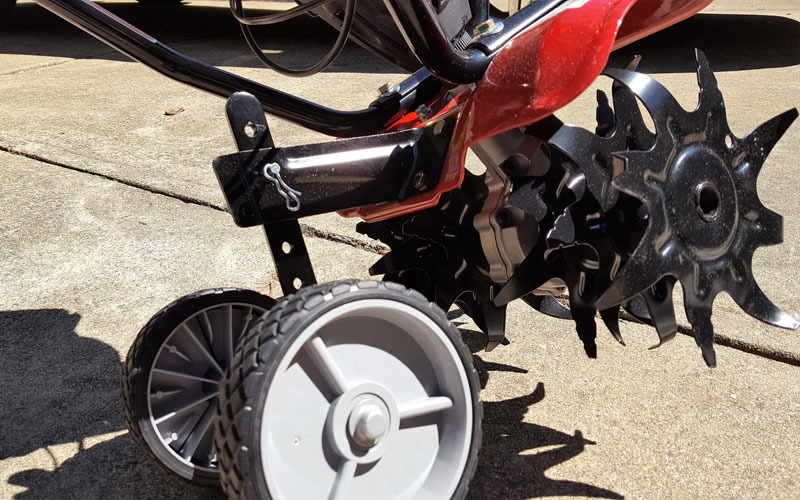
I found the wheels too thin and closely-spaced to give the unit good stability when rolling across uneven surfaces.
Where to Buy
You can find this on Amazon Prime, and for less than $45 more, you can also get the JumpStart™ engine starter.
No products found.
Last update on 2024-04-27 / Affiliate links / Images from Amazon Product Advertising API
Enjoyed This Review?
If you liked this review, please sign up for our email updates with reviews, how-to articles and gardening videos!

